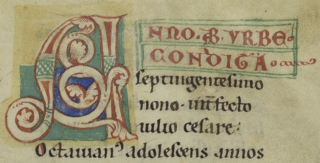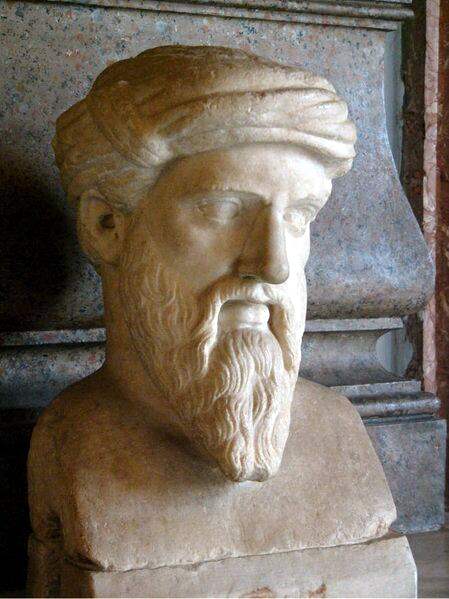
The terms anno Domini (AD) and before Christ (BC) are used to label or number years in the Julian and Gregorian calendars. The term anno Domini is Medieval Latin and means 'in the year of the Lord', but is often presented using "our Lord" instead of "the Lord", taken from the full original phrase "anno Domini nostri Jesu Christi", which translates to 'in the year of our Lord Jesus Christ'.

Ab urbe condita, or anno urbis conditae, abbreviated as AUC or AVC, express a date in years since 753 BC, the traditional founding of Rome. It is an expression used in antiquity and by classical historians to refer to a given year in Ancient Rome. In reference to the traditional year of the foundation of Rome, the year 1 BC would be written AUC 753, whereas AD 1 would be AUC 754. The foundation of the Roman Empire in 27 BC would be AUC 727.
The Julian calendar, proposed by Julius Caesar in AUC 708, was a reform of the Roman calendar. It took effect on 1 January AUC 709 , by edict. It was designed with the aid of Greek mathematicians and astronomers such as Sosigenes of Alexandria.

The Roman calendar was the calendar used by the Roman kingdom and republic. The term often includes the Julian calendar established by the reforms of the dictator Julius Caesar and emperor Augustus in the late 1st century BC and sometimes includes any system dated by inclusive counting towards months' kalends, nones, and ides in the Roman manner. The term usually excludes the Alexandrian calendar of Roman Egypt, which continued the unique months of that land's former calendar; the Byzantine calendar of the later Roman Empire, which usually dated the Roman months in the simple count of the ancient Greek calendars; and the Gregorian calendar, which refined the Julian system to bring it into still closer alignment with the tropical year.
AD 1 (I), 1 AD or 1 CE is the epoch year for the Anno Domini calendar era. It was the first year of the Common Era (CE), of the 1st millennium and of the 1st century. It was a common year starting on Saturday or Sunday, a common year starting on Saturday by the proleptic Julian calendar, and a common year starting on Monday by the proleptic Gregorian calendar. In the Roman Empire, 1 AD was known as the Year of the Consulship of Caesar and Paullus, named after Roman consuls Gaius Caesar and Lucius Aemilius Paullus, and less frequently, as year 754 AUC within the Roman Empire. The denomination "AD 1" for this year has been in consistent use since the mid-medieval period when the anno Domini (AD) calendar era became the prevalent method in Europe for naming years. It was the beginning of the Christian/Common era. The preceding year is 1 BC; there is no year 0 in this numbering scheme. The Anno Domini dating system was devised in AD 525 by Dionysius Exiguus.
The proleptic Julian calendar is produced by extending the Julian calendar backwards to dates preceding AD 8 when the quadrennial leap year stabilized. The leap years that were actually observed between the implementation of the Julian calendar in 45 BC and AD 8 were erratic: see the Julian calendar article for details.
The Julian day is the continuous count of days since the beginning of the Julian period, and is used primarily by astronomers, and in software for easily calculating elapsed days between two events.
In chronology and periodization, an epoch or reference epoch is an instant in time chosen as the origin of a particular calendar era. The "epoch" serves as a reference point from which time is measured.
Year 8 BC was either a common year starting on Friday or Saturday or a leap year starting on Thursday of the Julian calendar and a common year starting on Wednesday of the Proleptic Julian calendar. At the time, it was known as the Year of the Consulship of Censorinus and Gaius Asinius. The denomination 8 BC for this year has been used since the early medieval period, when the Anno Domini calendar era became the prevalent method in Europe for naming years.
Year 46 BC was the last year of the pre-Julian Roman calendar. At the time, it was known as the Year of the Consulship of Caesar and Lepidus. The denomination 46 BC for this year has been used since the early medieval period, when the Anno Domini calendar era became the prevalent method in Europe for naming years.
Year 45 BC was either a common year starting on Thursday, Friday or Saturday or a leap year starting on Friday or Saturday and the first year of the Julian calendar and a leap year starting on Friday of the Proleptic Julian calendar. At the time, it was known as the Year of the Consulship of Caesar without Colleague. The denomination 45 BC for this year has been used since the early medieval period, when the Anno Domini calendar era became the prevalent method in Europe for naming years.
Year 222 BC was a year of the pre-Julian Roman calendar. At the time it was known as the Year of the Consulship of Marcellus and Calvus. The denomination 222 BC for this year has been used since the early medieval period, when the Anno Domini calendar era became the prevalent method in Europe for naming years.

Dionysius Exiguus was a 6th-century Eastern Roman monk born in Scythia Minor. He was a member of a community of Scythian monks concentrated in Tomis, the major city of Scythia Minor. Dionysius is best known as the inventor of Anno Domini (AD) dating, which is used to number the years of both the Gregorian calendar and the (Christianised) Julian calendar. Almost all churches adopted his computus for the dates of Easter.
A calendar era is the period of time elapsed since one epoch of a calendar and, if it exists, before the next one. For example, it is the year 2022 as per the Gregorian calendar, which numbers its years in the Western Christian era.
Annianus of Alexandria was a monk who flourished in Alexandria during the bishopric of Theophilus of Alexandria around the beginning of the 5th century. He criticized the world history of his contemporary monk Panodorus of Alexandria for relying too much on secular sources rather than biblical sources for his dates.
The Ethiopian calendar, Eritrean calendar, or the Ge'ez calendar is the official calendar in Ethiopia. It is used as both the civil calendar and an ecclesiastical calendar. It is the liturgical year for Ethiopian and Eritrean Christians belonging to the Orthodox Tewahedo Churches, Eastern Catholic Churches, and Eastern Protestant Christian P'ent'ay Churches. Most Protestants in the diaspora have the option of choosing the Ethiopian calendar or the Gregorian calendar for religious holidays, with this option being used given that the corresponding eastern celebration is not a public holiday in the western world. The Ethiopian calendar is a solar calendar that has more in common with the Coptic calendar of the Coptic Orthodox Church of Alexandria and Coptic Catholic Church, but like the Julian calendar, it adds a leap day every four years without exception, and begins the year on 29 August or 30 August in the Julian calendar. A gap of seven to eight years between the Ethiopian and Gregorian calendars results from an alternative calculation in determining the date of the Annunciation.
The Era of the Martyrs, also known as the Diocletian era, is a method of numbering years used by the Church of Alexandria beginning in the 4th century AD and by the Coptic Orthodox Church of Alexandria from the 5th century to the present. Western Christians were aware of it but did not use it. It was named for the Roman Emperor Diocletian who instigated the last major persecution against Christians in the Empire. Diocletian began his reign on 20 November 284, during the Alexandrian year that began on 1 Thoth, the Egyptian New Year, or 29 August 284, so that date was used as the epoch: year one of the Diocletian era began on that date. This era was used to number the year in Easter tables produced by the Church of Alexandria.
In ancient Rome, the fasti were chronological or calendar-based lists, or other diachronic records or plans of official and religiously sanctioned events. After Rome's decline, the word fasti continued to be used for similar records in Christian Europe and later Western culture.
A year zero does not exist in the Anno Domini (AD) calendar year system commonly used to number years in the Gregorian calendar ; in this system, the year 1 BC is followed directly by year AD 1. However, there is a year zero in both the astronomical year numbering system, and the ISO 8601:2004 system, the interchange standard for all calendar numbering systems. There is also a year zero in most Buddhist and Hindu calendars.
The Gregorian calendar is the calendar used in most of the world. It was introduced in October 1582 by Pope Gregory XIII as a modification of, and replacement for, the Julian calendar. The principal change was to space leap years differently so as to make the average calendar year 365.2425 days long, more closely approximating the 365.2422-day 'tropical' or 'solar' year that is determined by the Earth's revolution around the Sun. The rule for leap years is:
Every year that is exactly divisible by four is a leap year, except for years that are exactly divisible by 100, but these centurial years are leap years if they are exactly divisible by 400. For example, the years 1700, 1800, and 1900 are not leap years, but the years 1600 and 2000 are.




